Are you tired of letting your garden’s green tomatoes go to waste? Learn how to transform those underripe gems into a jar of mouthwatering Salsa Verde. With just a few simple steps, you can preserve the taste of summer and add a tangy burst of flavor to any dish.
From gathering fresh green tomatoes to mastering water bath canning, I’ll guide you through the process, ensuring that every bite of your homemade Salsa Verde is a savory delight. So get ready to transform ordinary green tomatoes into a versatile condiment that will elevate your favorite dishes. Let’s start creating your own homemade Salsa Verde today!
This recipe comes from the Ball Complete Book of Home Preserving on page 210.
Gathering Fresh Green Tomatoes
Before jumping into the process of preparing the ingredients for your homemade Salsa Verde, it’s important to start with the star of the show: fresh green tomatoes. While you can certainly find green tomatoes at your local grocery store, there’s something special about plucking them straight from your garden. That satisfying feeling of harvesting your produce adds an extra layer of joy to the salsa-making process.
If you’re lucky enough to have a bountiful tomato garden, take a walk among the plants and keep an eye out for those vibrant, unripe tomatoes. Look for firm and evenly colored ones, ensuring they haven’t started to turn yellow or ripen. The ideal green tomatoes for Salsa Verde are slightly firm, yet still tender enough to be easily diced and cooked down into a deliciously tangy salsa.
If you don’t have a garden of your own, farmers’ markets are also a great place to find an array of green tomatoes. Chat with the local growers, ask about their farming practices, and select tomatoes that have been recently harvested for the freshest flavor.
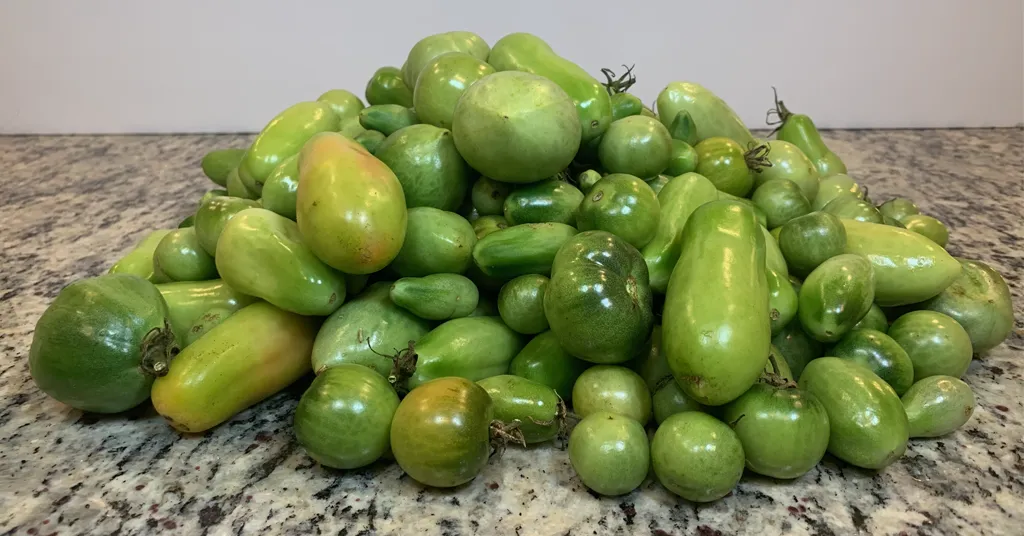
Ingredients for Salsa Verde
Now that you have your green tomatoes, you’ll want to ensure that the rest of your ingredients are equally fresh and flavorful.
- 7 cups (1.75 L) chopped, cored, peeled green tomatoes
- 5 to 10 jalapeno peppers, seeded and finely chopped
- 2 cups (500 mL) finely chopped red onions
- 2 cloves garlic, finely chopped
- 1/2 cup (125 mL) lime juice
- 1/2 cup (125 mL) loosely packed finely chopped cilantro
- 2 tsp (10 mL) ground cumin
- 1 tsp (5 mL) dried oregano
- 1 tsp (5 mL) salt
- 1 tsp (5 mL) freshly ground black pepper
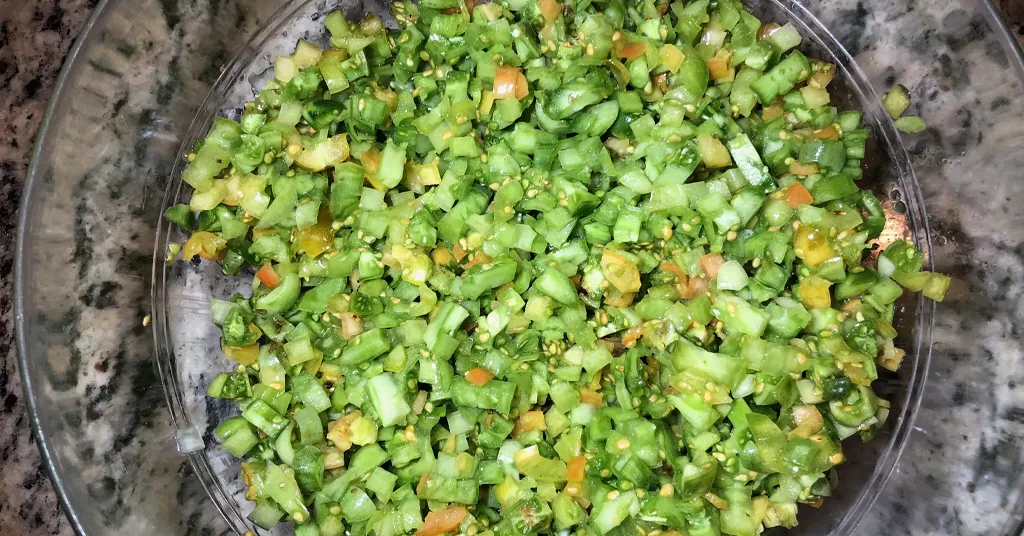
Grab a handful of fresh cilantro. This herb will bring a burst of freshness and aromatic flavor to your salsa. Give the cilantro a quick rinse, then chop it finely, including both the leaves and stems.
To add some heat and complexity to your salsa verde, gather 5 to 10 of jalapeno peppers. Depending on your tolerance for spice, you can adjust the number of jalapenos you use up to 10. Remove the seeds and ribs from the peppers if you prefer a milder salsa, or leave them in for a spicier kick. In canning a pepper is a pepper, in this recipe you can use a variety of hot or sweet peppers to regulate the heat in this salsa, just don’t add more peppers then the recipe calls for.
You’ll need 2 cloves of fresh garlic and 2 cups of red onions to round out the flavors. Peel and finely chop the garlic, and finely chop your red onions. These aromatic ingredients will provide a savory base for your salsa verde.
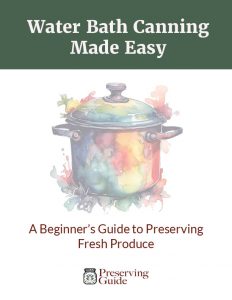
Water Bath Canning Made Easy
Preserve the flavors of your favorite fruits and vegetables with my FREE comprehensive and beginner-friendly Water Bath canning eBook.
Supplies Needed for Salsa Verde
Water Bath or Steam Canning Process
This recipe makes about six 8-ounce (250 mL) jars or three pint (500 mL) jars of Salsa Verde. Below is a list of the equipment you need for this recipe.
- Cutting Board
- Knife
- Large Stainless Steel Pot
- Spoon
- Measuring cups
- Measuring spoons
- Liquid Measuring Cups
- Water Bath Canner or Steam Canner
- 8-ounce (250 mL) or pint (500 mL) jars
- Regular or wide-mouth canning lids (depending on what jars you are using)
- Regular or wide-mouth canning rings (depending on what jars you are using)
- 1/2 Pint Canning Ladle
- Jar Lifter
- De-bubbler
- Headspace Measurer
With your salsa verde ingredients prepped, it’s time to move on to the next step in preserving its deliciousness for the long haul. The water bath canning or steam canning process are tried-and-true methods that will ensure your homemade creation stays fresh and flavorful for months to come.
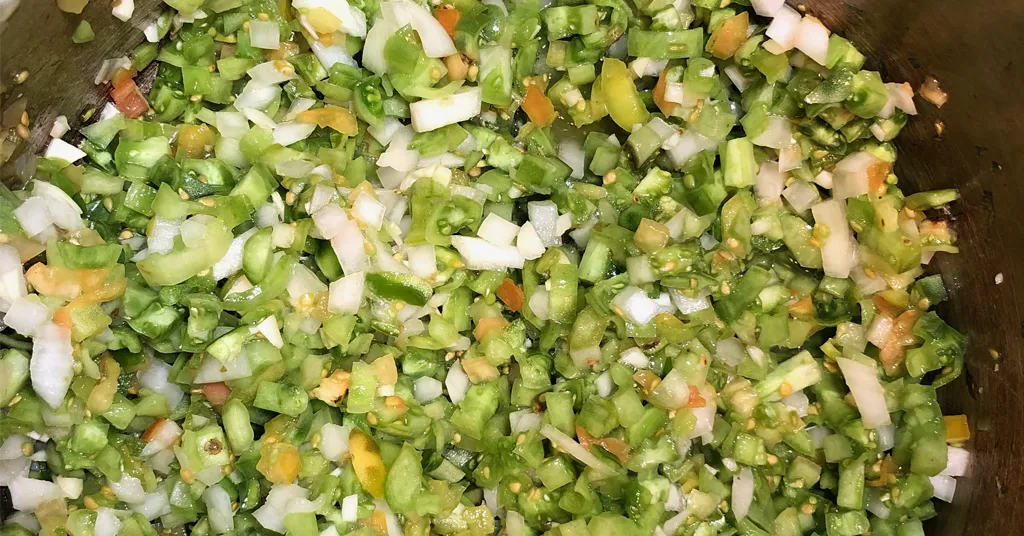
Step-by-Step Process
- Clean jars and lids with warm, soapy water. Ensure the jars do not have any chips or bubbles in the glass.
- Prepare your canner
- Using Water Bath Canner:
- Put your water bath canner on your stove. Add your canning rack to the water bath canner. Add your 1/2 pint or pint jars to the water bath canner. They will warm as you heat the water. Add enough water to cover jars with at least 2-3 inches of water. Start to bring your water to a boil.
- Using a Steam Canner:
- Put your steam canner on your stove. Add the steam canner rack to the bottom of the steam canner. Add the recommended amount of water to the steam canner according to the manufacturer. Add your 1/2 pint or pint jars to the steam canner. Put the lid on your steam canner and start your stove. The jars will warm as you heat your steam canner.
- Using Water Bath Canner:
- In a large stainless steel saucepan, combine tomatoes, peppers, onions, garlic, and lime juice. Bring to a boil over medium-high heat, stirring constantly.
- Stir in cilantro, cumin, oregano, salt, and black pepper. Reduce heat and boil gently, stirring frequently, for 5 minutes. Remove from heat.
- Once you have hot jars and hot salsa
- Water Bath Canner:
- Remove your jars from the water bath canner one at a time using your jar lifter. Dump the water out of the jar into your water bath canner to ensure there is still 2-3 inches of water above your jars.
- Steam Canner:
- Remove the steam canner lid and remove your jars one at a time using your jar lifter.
- Water Bath Canner:
- Ladle the hot salsa into the hot jar. Leave 1/2 inch (1 cm) headspace (use your headspace measurer to verify the correct amount). Using your de-bubbler make sure to remove all air bubbles. Adjust headspace, if necessary, by adding additional hot salsa.
- Wipe the rim of the jar to ensure a good seal is made with the lid. Center the lid on the jar and add the band to fingertip tight. Put the jar back into the canner using your jar lifter.
- Repeat until all salsa has been used.
- Processing
- Water Bath Canner:
- Lower the water bath canner rack into the boiling water. Ensure your jars are covered by at least 2 inches of water.
- If your water is not boiling start your processing time when the water is boiling. Process 1/2 pint and pint jars for 20 minutes. Make sure to adjust your time for altitude.
- Set a timer, it makes it much easier to make sure you process for the correct time. When your timer goes off turn off the heat and remove the canner lid.
- Leave the jars in the water for 5 minutes.
- Steam Canner:
- Put the lid on the steam canner. Turn your stove on high until your steam canner water comes to a vigorous boil. Continue heating so the indicator is in the correct “Zone” per your altitude.
- Start your processing time when the needle reaches the maximum point you have tested your steam canner to reach in your “Zone”.
- Adjust the burner so that it maintains an even rolling boil throughout the entire processing time. Usually, this will be much lower than where it was set for the vigorous boil. If the top lid is lifting and/or spitting water from the edges this is an indication that you have the heat turned up too high. Slowly reduce the heat until this stops. Watch the indicator to ensure the temperature does not decrease.
- The processing times for steam canning are the same as for water bath canning. Process 1/2 pint and pint jars for 20 minutes.
- Make sure to adjust your time for altitude.
- Set a timer, it makes it much easier to make sure you process for the correct time.
- When your timer goes off turn off the heat and let the canner stand for 5 minutes with the lid on before removing the jars. The lid MUST remain ON the canner during this time. This cool-down period is necessary to ensure the jar contents are properly processed.
- Carefully remove the lid by tilting it away from you to avoid steam burns.
- Water Bath Canner:
- Using your jar lifer carefully move the jars onto a wire rack or kitchen towel to allow them to cool. When moving the jars try not to tilt them to the side as this could affect the seal of the jars. Allow your jars to cool for 12-24 hours before handling.
- Once cool, remove the canning rings from the jars. Wash your jars off to ensure no food residue on the outside of the jar from processing. Label your jar with the name of the recipe and date. This will help you remember what recipe you used to can and the date will allow you to use the oldest canned goods first.

Join My Preserving Guide Facebook Group
Expert tips, tested recipes, and vibrant discussions on canning, dehydrating, freezing, and all things food preservation!
Enjoying Your Homemade Salsa Verde
Once you’ve completed the water bath or steam canning process and sealed your jars of salsa verde, it’s time to sit back, relax, and savor the fruits of your labor. There’s something incredibly satisfying about enjoying a homemade condiment that you prepared from scratch – the vibrant flavors, the zesty kick, and the knowledge that you nurtured each ingredient from garden to jar.
To fully appreciate your homemade salsa verde, it’s essential to pair it with the right dishes. The tangy and slightly spicy flavors of the salsa verde make it a versatile condiment that can elevate a wide range of meals. Whether you’re looking to brighten up a simple plate of scrambled eggs, add zing to your tacos, or drizzle it over grilled vegetables, this green tomato salsa will bring your taste buds to life.
One of the simplest and most delicious ways to enjoy your homemade salsa verde is by using it as a dipping sauce. Its vibrant green color and tangy flavors make it the perfect accompaniment for tortilla chips, pita bread, or even crispy vegetable sticks. The combination of the crunchy texture and the burst of flavor from the salsa verde creates a delightful snack that will leave you coming back for more.
If you’re feeling adventurous, you can incorporate salsa verde into your favorite recipes to take them to the next level. Use it as a marinade for grilled chicken or fish, allowing the flavors to infuse and transform the proteins into mouthwatering creations. Or, add a dollop of salsa verde to your sandwiches and wraps, giving them a burst of freshness and a unique twist.
As you savor the deliciousness of your homemade salsa verde, take a moment to appreciate the satisfaction of transforming green tomatoes into a culinary masterpiece. Every jar represents not only the flavors of summer but also the care and attention you poured into growing, harvesting, and preserving the ingredients. So, whether you’re enjoying it at a family gathering, sharing it with friends, or simply indulging in a moment of self-appreciation, relish in the taste of your very own salsa verde.
Additional Salsa Recipes
Salsa is one of my favorite things to preserve for my family. Here are some of my favorite salsa recipes:
Recipe Card
Salsa Verde
Equipment
- Water Bath Canner or Steam Canner
- Steam Canner or Water Bath Canner
- 1/2 Pint Sized Canning Jars or pint sized canning jars
- Pint Size Canning Jars or 1/2 pint sized canning jars
Ingredients
- 7 cups chopped, cored, peeled green tomatoes
- 5 to 10 Jalapeno Peppers
- 2 cups Finely Chopped Red Onion
- 2 cloves Garlic finely chopped
- 1/2 cup Lime Juice
- 1/2 cup Loosely Packed Finely Chopped Cilantro
- 2 tsp Ground Cumin
- 1 tsp Dried Oregano
- 1 tsp salt
- 1 tsp Freshly Ground Black Pepper
Want to Save this Recipe?
Instructions
- Clean jars and lids with warm, soapy water. Ensure the jars do not have any chips or bubbles in the glass.
- Prepare your cannerUsing Water Bath Canner: Put your water bath canner on your stove. Add your canning rack to the water bath canner. Add your 1/2 pint or pint jars to the water bath canner. They will warm as you heat the water. Add enough water to cover jars with at least 2-3 inches of water. Start to bring your water to a boil.Using a Steam Canner: Put your steam canner on your stove. Add the steam canner rack to the bottom of the steam canner. Add the recommended amount of water to the steam canner according to the manufacturer. Add your 1/2 pint or pint jars to the steam canner. Put the lid on your steam canner and start your stove. The jars will warm as you heat your steam canner.
- In a large stainless steel saucepan, combine tomatoes, peppers, onions, garlic, and lime juice. Bring to a boil over medium-high heat, stirring constantly.
- Stir in cilantro, cumin, oregano, salt, and black pepper. Reduce heat and boil gently, stirring frequently, for 5 minutes. Remove from heat.
- Once you have hot jars and hot salsaWater Bath Canner:Remove your jars from the water bath canner one at a time using your jar lifter. Dump the water out of the jar into your water bath canner to ensure there is still 2-3 inches of water above your jars.Steam Canner:Remove the steam canner lid and remove your jars one at a time using your jar lifter.
- Ladle the hot salsa into the hot jar. Leave 1/2 inch (1 cm) headspace (use your headspace measurer to verify the correct amount). Using your de-bubbler make sure to remove all air bubbles. Adjust headspace, if necessary, by adding additional hot salsa.
- Wipe the rim of the jar to ensure a good seal is made with the lid. Center the lid on the jar and add the band to fingertip tight. Put the jar back into the canner using your jar lifter.
- Repeat until all salsa has been used.
- ProcessingWater Bath Canner:Lower the water bath canner rack into the boiling water. Ensure your jars are covered by at least 2 inches of water.If your water is not boiling start your processing time when the water is boiling. Process 1/2 pint and pint jars for 20 minutes. Make sure to adjust your time for altitude.Set a timer, it makes it much easier to make sure you process for the correct time. When your timer goes off turn off the heat and remove the canner lid.Leave the jars in the water for 5 minutes.Steam Canner:Put the lid on the steam canner. Turn your stove on high until your steam canner water comes to a vigorous boil. Continue heating so the indicator is in the correct "Zone" per your altitude. Start your processing time when the needle reaches the maximum point you have tested your steam canner to reach in your "Zone".Adjust the burner so that it maintains an even rolling boil throughout the entire processing time. Usually, this will be much lower than where it was set for the vigorous boil. If the top lid is lifting and/or spitting water from the edges this is an indication that you have the heat turned up too high. Slowly reduce the heat until this stops. Watch the indicator to ensure the temperature does not decrease.The processing times for steam canning are the same as for water bath canning. Process 1/2 pint and pint jars for 20 minutes.Make sure to adjust your time for altitude. Set a timer, it makes it much easier to make sure you process for the correct time.When your timer goes off turn off the heat and let the canner stand for 5 minutes with the lid on before removing the jars. The lid MUST remain ON the canner during this time. This cool-down period is necessary to ensure the jar contents are properly processed.Carefully remove the lid by tilting it away from you to avoid steam burns.
- Using your jar lifer carefully move the jars onto a wire rack or kitchen towel to allow them to cool. When moving the jars try not to tilt them to the side as this could affect the seal of the jars. Allow your jars to cool for 12-24 hours before handling.
- Once cool, remove the canning rings from the jars. Wash your jars off to ensure no food residue on the outside of the jar from processing. Label your jar with the name of the recipe and date. This will help you remember what recipe you used to can and the date will allow you to use the oldest canned goods first.
Notes
Editorial Process
At Preserving Guide, I take pride in my thorough and impartial approach to recipe and product reviews. Read my editorial process for detailsRobin
Robin Phelps has been preserving food for her family for over 20 years. Today, Robin is a full-time home preservation blogger and coach. Join Robin to learn how to easily make delicious and safe homemade preserved items.


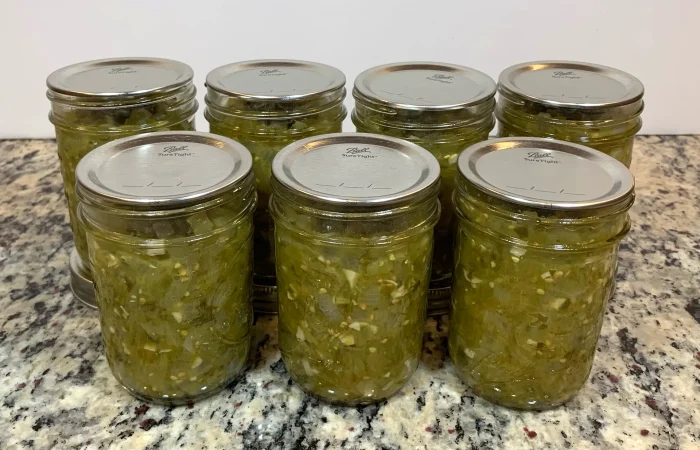
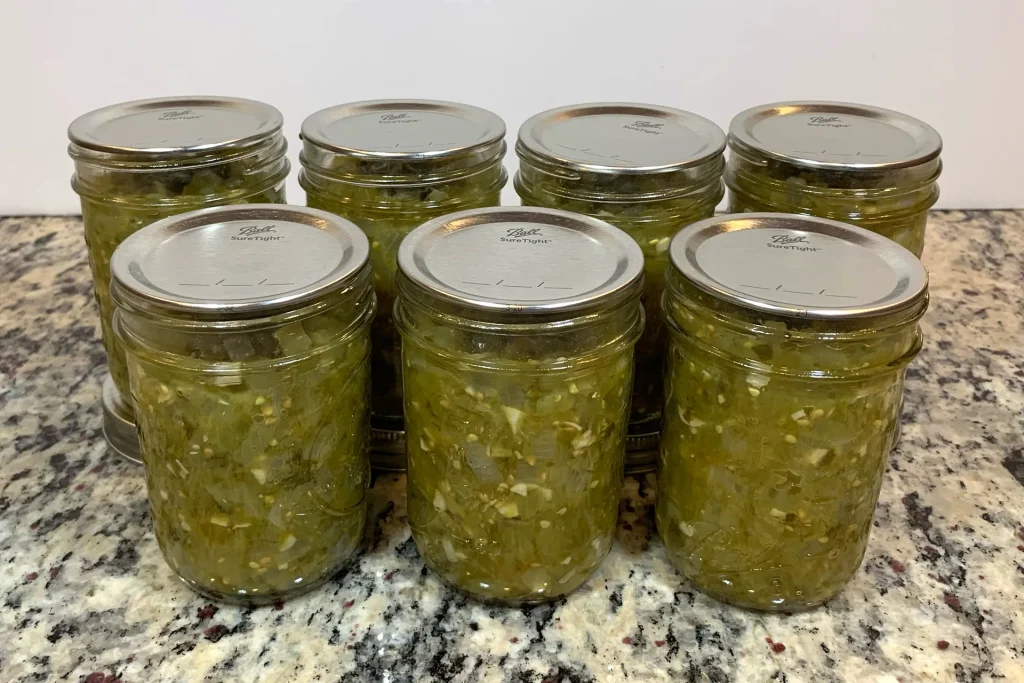

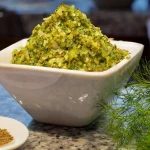
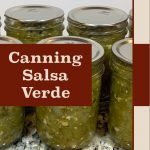
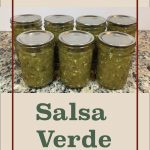
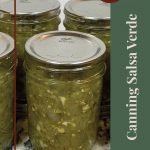
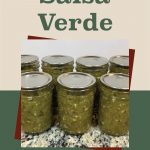
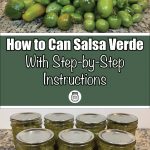
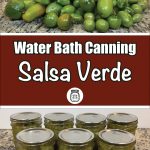


Hi Robin,
Do you use fresh or bottled lime juice for your salsa verde? I’m excited about using my large bounty of green tomatoes.
Thank you,
Cindy
Hi Cindy. I use bottled lime juice for this recipe.